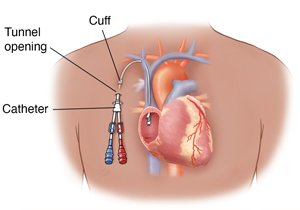Tunneled Catheters for Hemodialysis
Hemodialysis is a type of treatment for kidney failure (end-stage kidney disease or ESRD). During hemodialysis, blood is removed from your body and filtered through a dialysis machine (dialyzer). The filtered blood is then returned to your body.
Before hemodialysis can be done, you need a way to access your bloodstream (called a vascular access). There are 3 types of vascular access for hemodialysis:
This sheet focuses on tunneled catheters.
What is a tunneled catheter?

Both the AV fistula and AV graft are the main types of vascular access. They are used for permanent access. Both require surgery to put in place. And it can take a few weeks for them to be ready to use.
A tunneled catheter is an option for short-term use or when other vascular access can’t be used. The catheter is a thin, plastic tube that’s put into a large blood vessel, usually in the neck or chest. It’s called tunneled because it’s inserted under the skin. One end of the catheter is put into the blood vessel. The other end remains outside your body. There is a cap on the end that’s outside your body. This cap must stay tightly closed except when you have hemodialysis. Then a dialysis team member removes the cap and attaches the catheter to the dialysis machine. The cap is put back on again after dialysis.
Unlike an AV fistula or graft, a tunneled catheter doesn’t require any surgery. So once the catheter is in place, it can be used right away. There’s also no need to puncture the skin to access the vein each time you have dialysis.
A tunneled catheter has 2 access ports:
When is a tunneled catheter used?
A tunneled catheter is used when vascular access is needed right away. It’s used when someone:
-
Needs emergency (acute) dialysis
-
Is waiting for a kidney transplant
-
Is waiting to have an AV fistula or graft put in
-
Can’t have an AV fistula or graft because their blood vessels are too weak
There are 2 types of tunneled catheters: non-cuffed and cuffed.
-
Non-cuffed tunneled catheters. These are used in emergency dialysis. They can be used for about 3 weeks.
-
Cuffed tunneled catheters. These may be used for longer than 3 weeks in some cases. For instance, if someone is getting an AV fistula or graft, but it’s not ready yet. Or if someone is unable to have a fistula or graft.
Caring for a tunneled catheter
To prevent infection, it’s vital to keep a tunneled catheter clean and dry at all times. Follow these tips to keep your catheter working well and prevent complications:
-
Always keep the dressing around the catheter dry and clean.
-
Always keep the cap at the end of the catheter closed. Never open it. Only a dialysis team member should open the cap.
-
Be sure your dialysis care team always changes the dressing each time you get dialysis.
-
Don’t touch the catheter. Doing so can lead to infection.
-
Never use scissors or other sharp objects near the catheter.
-
Keep a mask over your mouth and nose whenever a dialysis team member opens the catheter. This prevents bacteria from getting into the catheter and into your blood. Dialysis team members who change your dressing should always use a mask and gloves too.
-
Be very careful when bathing or showering. Always use a clear, waterproof dressing. This should stick to the catheter site and the skin around it. It also lets you see if there’s an infection. Never let the catheter get wet or go under water. If possible, use a handheld shower head. Keep the water spray away from your catheter.
-
Always have emergency dressing supplies on hand. There may be times when you need to redo the dressing. Your dialysis team can show you how to do this.
Risks and possible complications
A tunneled catheter has the following risks and possible complications:
-
The catheter can get infected
-
Blood clots can form, reducing blood flow
-
It can damage the vein in your neck
-
It may not be comfortable
When to call your healthcare provider
Call your healthcare provider or your dialysis team right away if any of these occur after a tunneled catheter is inserted:
-
Signs of a catheter infection, such as:
-
Redness, warmth, or pain at the catheter exit site
-
Itching or swelling around your catheter
-
Fluid leaking from the catheter exit site
-
Fever
-
Chills
-
The catheter is pulled out by mistake and there’s bleeding at the exit site
-
The catheter is damaged (there is a crack, cut, or hole in it)
-
You’re injured at the catheter exit site